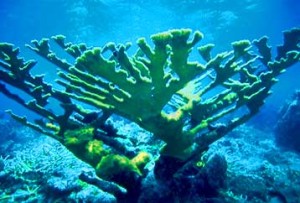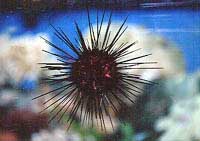Mary, Mary, quite contrary,
How does your coral reef grow?
Below the swells with pink conch shells,
And pretty seafans in a row.
How does Coral Grow?
The life cycle of the coral begins with the fertilization of an egg and subsequent larval development, the larva floats or crawls to a suitable location and attaches to a suitable substrate. At this time, the larva  develops into a coral polyp. Limestone is secreted around the polyp cementing the coral firmly to the substrate. Tentacles covered with microscopic stinging cells protect the coral from would-be predators and stun planktonic prey. Growth by division of daughter polyps (yes, each mass of coral you see are all clones) which produce the skeleton you know as coral. The more rapid-growing staghorn and elkhorn corals can grow 4 or 5 inches a year. The massive star and brain corals grow only 1/2 inch per year.
develops into a coral polyp. Limestone is secreted around the polyp cementing the coral firmly to the substrate. Tentacles covered with microscopic stinging cells protect the coral from would-be predators and stun planktonic prey. Growth by division of daughter polyps (yes, each mass of coral you see are all clones) which produce the skeleton you know as coral. The more rapid-growing staghorn and elkhorn corals can grow 4 or 5 inches a year. The massive star and brain corals grow only 1/2 inch per year.
Corals and other reef builders (algae, mollusks, worms etc.) use carbon dioxide, a product of respiration, and combine it with calcium from seawater to form a limestone (calcium carbonate) skeleton. In corals, the energy required to do this comes from microscopic algae living inside the coral’s tissue. Photosynthesis by the algae (zooxanthellae) provides the sugars, carbohydrates and fats necessary to support the coral’s metabolism. This relationship is termed endosymbiosis, the coral and algae are each dependent upon each other for survival. (Who said algae was killing the coral reefs?) The number of zooxanthellae in a square inch of coral tissue can range from 1 million to 2 million. (For some reason that makes me itch.) Reef building corals evolved in tropical waters deficient in nutrients. The endosymbiosis provides the energy needed for maintenance, growth, and reproduction of these reef corals.
Reef Building Coral Needs
Strong Sunlight
The Coral Algae must have long hours of strong sunlight for reef growth.
Clear water
Without clear water (lacking sediments, particulate material, and high plankton counts) to allow the light through reef building coral can not development. Areas with chronic silt and runoff from the land and high plankton counts usually lack coral reefs. As you drive the overseas highway between Islamorada and Long Key, you can see silting in action.
Nutrients
The Coral Algae require nutrients similar to land based plants to utilize the energy from sunlight to produce the foods for growth and to provide energy for the corals. These nutrients include nitrogen and phosphorus. There must be a delicate balance of these nutrients to feed the coral algae without causing an increase in plankton.
Link Between Healthy Reefs and Mangrove Forests
A study to be published February 2004 in the journal Nature has found the strongest link to date between the productivity of coral reef fisheries and the health of nearby mangrove forests. The study compared the numbers and amount of fish on reefs near mangrove forests to reefs far from any mangroves. One species, blue striped grunt, was found to be 26 times – or 2667 percent – more abundant on reefs near healthy mangroves, measured in total biomass.
“There is nothing subtle about these numbers,” said Dr. Peter Mumby, a researcher from the University of Exeter in England and the study’s lead author. “This research shows a direct link between mangroves and the number of fish on coral reefs including several species of snapper that are heavily fished. Protecting mangroves in association with reefs will provide a much bigger return on investment than only protecting reefs in isolation.”
Islands Protect Reef?
Larger keys form a natural dam that restricts water flow from Florida Bay into the Atlantic Ocean, which in turn affects the distribution and development of coral reefs. Key Largo is a 30 mile long key. Reef development seaward of Key Largo is extensive. (Now you know why they call Key Largo the Dive Capital of the World.) If you check your navigation charts you will see that coral reefs are well developed and concentrated in the region from Elliott Key, a 7 mile long island just to the north of Key Largo, to the southern end Key Largo. This begins again from Big Pine Key to beyond Key West, (check you charts and consider what the channels between the islands in the lower keys are like). Between south Key Largo and Big Pine Key, reefs are not as numerous or as well developed. Large and numerous openings between the keys (think Seven Mile Bridge) in the middle portion of the Florida Keys permit unrestricted water flow from Florida Bay into the Atlantic. This increases silting, and the amount of plankton in the water washing over the reefs producing less clear water.
Other Hazards to Coral
Temperature
Other natural hazards for the reef building corals are cold and hot water temperatures. Prolonged exposure to water temperatures of less than 64 degrees F or greater than 85 degrees F is stressful, and in some cases deadly, to reef corals.
Storms
Hurricanes can cause damage to reefs. Following a hurricane recovery may take 5 to 10 years.
What does all this mean? Why are we suddenly hearing about problems with the reefs? It is easy to point to one cause and say this is why our reefs are declining. As more scientific studies are completed we are discovering there are many different complex causes. Here are some interesting recent theories.
Missing – Key Critters
 The loss of the Long Spined Black Sea Urchin, Diadema.
The loss of the Long Spined Black Sea Urchin, Diadema.
The reason for their decline has not yet been well defined. These urchins are heavy graziers of algae which grow on reef surfaces. Their loss has allowed the algae to grow uncontrolled covering over any substrates. This keeps new corals from colonizing and may kill existing corals by shading. Sponges filter feed on small particulate food such as bacteria, algae and other microscopic plankton. The loss of great numbers of sponges, due to commercial harvesting, has created an increase the amount of planktonic matter in the waters over the reefs.
A (Not-So)Lite Dusting
Every year millions of tons of African dust drift across the Atlantic on westerly trade winds and settle down throughout the Caribbean. Florida receives about 50% of this onslaught. This dust affects reefs through direct fertilization of algae by iron and other nutrients and bacterial, viral and fungal spores hitchhiking on the dust particles. The fungus affecting sea fans throughout the Caribbean has been identified as a land-based Aspergillus sp. a fungus that does not reproduce in sea water (Smith et al., 1996). Studies at the University of South Florida have shown a relationship between significant dust events and algal blooms, like the red tides that occur in Florida’s coastal waters.
In Hot Water
The warming of the seas by, take your pick, global warming – El Nino – changes in ocean currents, lack of or an increase of hurricanes can stress shallow water corals.
Don’t Let your Fingers do the Walking!
Too many divers are touching the reefs. Currently, there are approximately eighty dive shops located throughout the Keys, which take approximately nine hundred thousand divers and snorkelers to our reefs annually. If you dive you have seen the effects of the tremendous increase in divers on our reefs. Bare spots on shallow water brain corals where inexperienced divers have stood on them. Smaller coral colonies tipped over to see what was underneath, and not set right. Pieces of coral broken off by a diver grabbing hold to stabilize themselves. These more obvious signs are probably greatly out numbered by all the corals damaged by merely touching them without doing any structural damage.
Is it time for a “you touch it, you bought it” policy where there are $100 fines for every time a diver touches any part of the reef?
Waste Water Runoff
(This is a current favorite of local politicians and environmental activists) Within the fossilized coral reefs that make up much of the land area of the Florida Keys in Monroe County, there are at least 6,500 cesspits, 25,000 septic tanks, 900 shallow injection wells and other unknown systems being used for wastewater management. Daily tidal flushing through the porous limestone conveys inadequately treated, nutrient-rich wastewater entry into the nearshore coral reef system, the vitality of which is based on maintaining nutrient-poor waters.
Scientists Identify Important Source of Nutrients to Florida’s Coral Reefs
UNCW professor teams with Scripps and UC-Berkeley scientists to identify important source of nutrients to Florida’s coral reefs. Key Largo, Florida — Coral reef scientists were surprised to learn that the deep ocean is the source of 20-40 times more nitrogen and phosphorus on the outer coral reef than nutrient pollution from sewage and storm water runoff.
Another thought on this subject. I would like to see a study to determine which produced more nutrients in the waters over the outer reefs, wastewater runoff from islands 5 miles away or the daily heavy chumming and dumping of fish skeletons and by-catch of commercial and recreational fishing. You would, of course, have to consider the nutrients produced by both the decomposing chum, fish skeletons and by-catch and the waste produced by the fish eating the chum, fish skeletons and by-catch.
